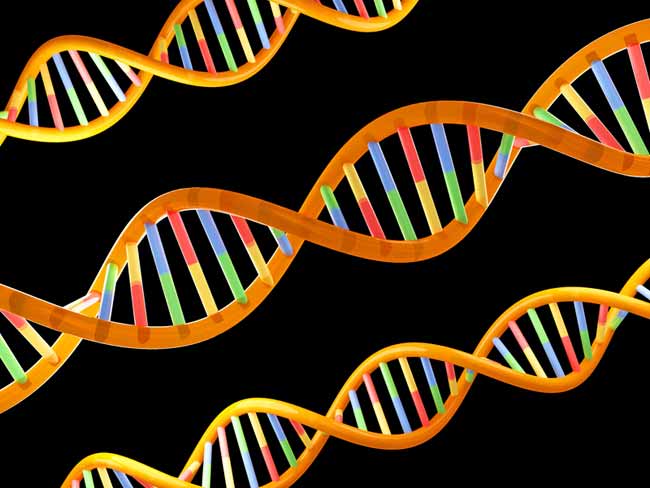New Artificial DNA Points to Alien Life

CHICAGO — A strange, new genetic code a lot like that found in all terrestrial life is sitting in a beaker full of oily water in a laboratory in Florida, a scientist said today, calling it the first example of an artificial chemical system that is capable of Darwinian evolution.
The system is made of the four molecules that are the basic building blocks of our DNA along with eight synthetic modifications of them, said biochemist Steven A. Benner of the Foundation for Applied Molecular Evolution in Gainesville.
The main difference between the synthetic molecules and those that make up conventional DNA is that Benner's molecules cannot make copies of themselves, although that is just "a couple of years" away, he said.
The wild biochemistry finding, described to a small group of reporters today at the annual meeting of the American Association for the Advancement of Science, offers ideas about new types of life for scientists to look for beyond our planet, or even possibly hidden on our planet.
"Unless it happens to shoot at you with a ray gun, the life that you encounter off of Earth will not necessarily have same biochemistry as us," Benner said.
And the step from Benner's system to something that could be called artificial life is still large. "There is not enough information in them to build organisms," Benner said.
Expanded alphabet for DNA
Get the world’s most fascinating discoveries delivered straight to your inbox.
For some 20 years, Benner's labs have been involved in trying to make artificial life or things approximating it, with similar genetic and inheritance properties to life on Earth. (Previously, Benner worked at the University of Florida.)
He and his colleagues have focused in part on expanding the DNA alphabet to develop an "Artificially Expanded Genetic Information System," which now has its own supporting molecular biology.
The building blocks of DNA are four chemicals called nucleotides that are referred to as A, C, T and G, for short. The nucleotides pair up and bond in predictable ways to form the double helix structure of DNA. Benner's new nucleotides, which he and his colleagues have named Z, P, V, J, Iso-C, Iso-G, X and K, are reshufflings of the constituents of those molecules found in our DNA.
The evolution in this system happens when the 12-letter genetic code makes copying mistakes and subsequent sequences have properties that make them more liable to get copied. Those sequences would survive in greater numbers than the original sequence.
Benner's synthetic approach was conceptualized using "ball and stick plastic model chemistry," he said, the technique used by James Watson and Francis Crick to arrive at the structure of the DNA molecule in 1953.
The human genome's DNA includes 3 billion base pairs. Some of the molecules synthesized in Benner's lab are 81 base pairs long — relatively short.
The molecules are "fed" and grow via a process called the polymerase chain reaction (PCR) that allows the molecules to make copies of themselves. Once the replication of the molecules in Benner's system is self-catalyzed, without PCR, the process is self-sustaining. Benner claims, "then it's artificial life."
Dreaming up extra-terrestrial life
The research resulted from a NASA-funded project to try to understand what life might look like beyond Earth. Such life might live in water, but it could also live in liquid nitrogen or methane (as speculated for Saturn's moon Titan) and in environments with extremely high or low acidity.
The results are published in a technical book, "Life, the Universe and the Scientific Method," of which Benner has made about 100 copies to distribute to his colleagues.
"One of the ways scientists try to understand life as a universal concept … is you try to make life on your own in the lab," Benner said. "We try to put together chemicals that do that."
Any potential life forms made from such molecules would be "so alien in terms of their biochemistry that they will not able to eat you," Benner said.
NASA has been involved in searching for extra-terrestrial life along numerous avenues for decades, including the Viking mission to Mars in the 1970s and its recent missions to the red planet which have searched for signs of habitability there. NASA also funds an Astrobiology Institute, which partners with hundreds of researchers world-wide who study of the origins, evolution, distribution and future of life in the universe
The trick to searching for alien life is how to look for it, said Paul Davies of Arizona State University, who also spoke with reporters here today.
"All of the techniques which microbiologists use to [look for alien life] are customized to life as we know it," Davies said. "It's no surprise that microbiologists haven't come across micro-organisms that seem to have relatively different biochemistry."
In the future, more scientists could "talk with Steve Benner," Davies said, "to come up with perfectly good molecules that life could use — but doesn't."
- Breakthrough Could Lead to Artificial Life Forms
- Genes: The Instruction Manual for Life
- All About DNA and Genes
Robin Lloyd was a senior editor at Space.com and Live Science from 2007 to 2009. She holds a B.A. degree in sociology from Smith College and a Ph.D. and M.A. degree in sociology from the University of California at Santa Barbara. She is currently a freelance science writer based in New York City and a contributing editor at Scientific American, as well as an adjunct professor at New York University's Science, Health and Environmental Reporting Program.

